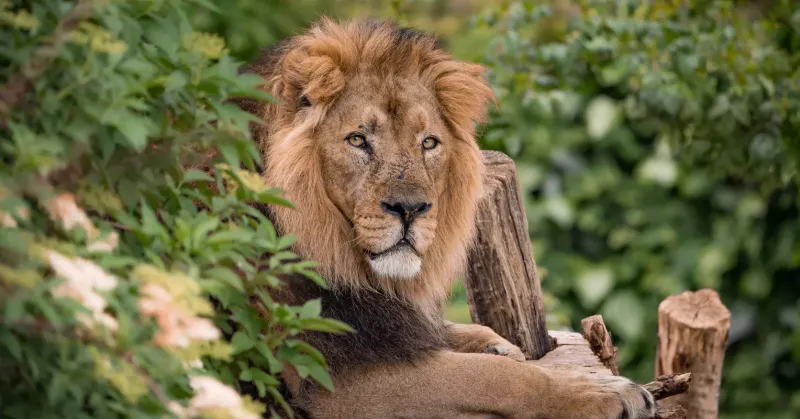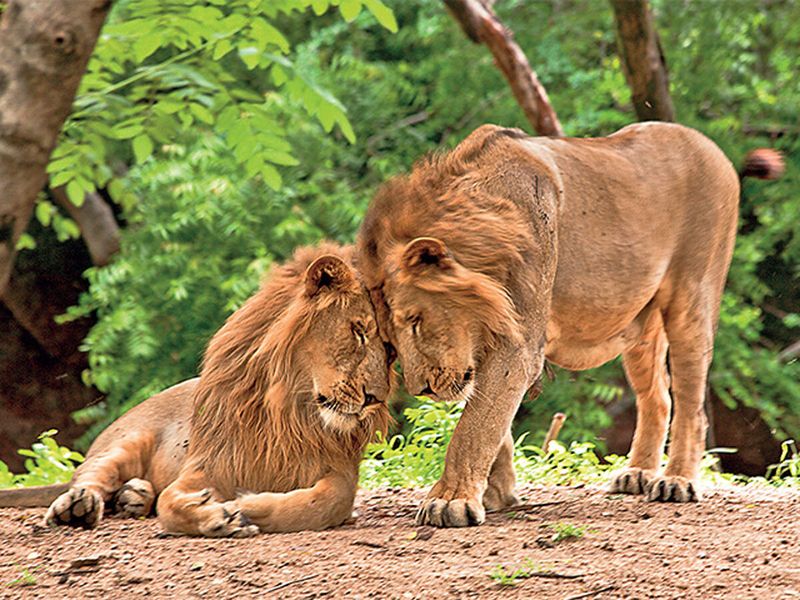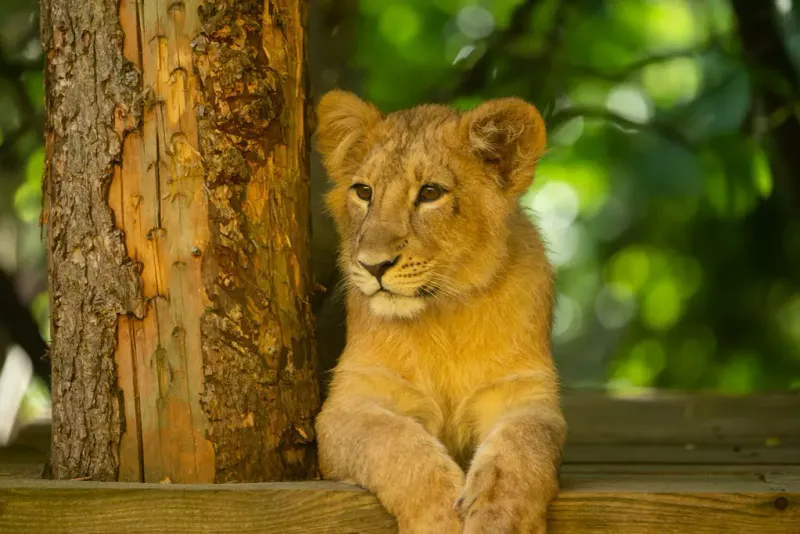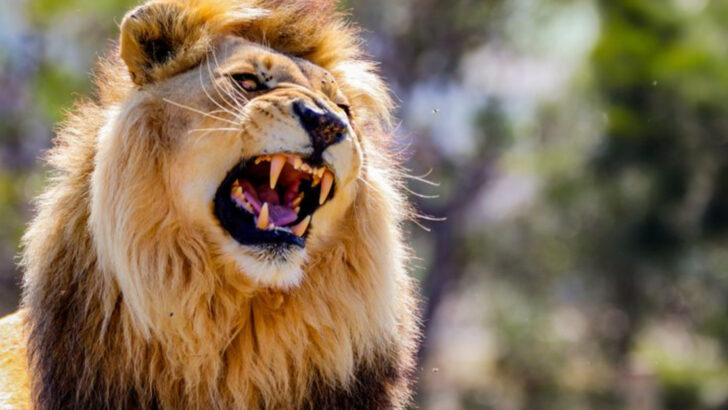The Asiatic lion is not just rare—it’s royalty on the edge.
With fewer than a thousand left in the wild, this big cat is one of nature’s most exclusive survivors, ruling the last pocket of its empire in India’s Gir Forest. You’ve heard of the African lion, sure. But this one? This is the lesser-known cousin with a story full of grit, history, and raw power.
Smaller mane. Shorter frame. Bigger comeback story.
Once prowling from the Middle East to India, now holding on to a single stronghold, the Asiatic lion has battled extinction—and is still standing, fierce and proud.
Ready to meet the lion you thought you knew?
These 13 facts go way beyond the basics.
Distinctive Belly Fold

One striking feature of the Asiatic lion is the distinctive fold of skin that runs along its belly. This unique characteristic sets it apart from its African relatives, who lack this feature.
The belly fold is not just a cosmetic difference; it plays a role in the lion’s flexibility, aiding in its movement through the dense forests of the Gir. Additionally, this distinctive trait has become a defining feature for identifying and studying these lions.
Observing such a distinct feature in a lion adds an element of intrigue to wildlife enthusiasts and researchers alike.
Smaller Pride Sizes

Unlike their African counterparts, Asiatic lions live in smaller prides, usually consisting of just two or three females and their cubs. This difference in social structure is largely due to the dense forest habitat they occupy, which supports fewer large prey animals.
Consequently, smaller pride sizes are more sustainable in such environments. The intimate family groups foster closer bonds among the members, which can be observed during their communal grooming and playful interactions.
These smaller prides highlight the adaptability of Asiatic lions to their specific surroundings.
Limited Roaring Range

The roar of the Asiatic lion is less resonant compared to the thunderous calls of African lions. This is due to the different environmental settings they inhabit.
In the closed forests of India, a far-reaching roar is less necessary than in open savannas, where African lions reside. The quieter roar allows them to communicate effectively over shorter distances without drawing too much attention from potential threats.
This adaptation emphasizes their evolutionary divergence, catering to communication needs specific to their habitat.
Historic Royal Companions

Asiatic lions have a long history as symbols of royalty and power in India. They were often kept in the menageries of Indian kings and depicted in ancient art and sculptures as majestic companions of the rulers.
Their regal presence was believed to enhance the king’s status, projecting an image of strength and dominion. Today, these lions continue to hold cultural significance, representing resilience and heritage.
This historical connection adds an element of grandeur and mystique to their already fascinating existence.
Strategic Hunting Skills

Asiatic lions exhibit remarkable hunting strategies adapted to their forested habitats. Unlike the open savannas, the Gir Forest requires stealth and precision.
Lionesses often hunt alone or in pairs, using the dense underbrush for cover. Their hunting technique involves silent stalking and quick bursts of speed to ambush prey. This strategy is essential for survival, given the limited visibility and smaller prey availability.
Witnessing an Asiatic lion on the hunt provides a glimpse into the incredible adaptability and cunning of these magnificent predators.
Conservation Success Story

The Asiatic lion’s survival is a testament to successful conservation efforts in India. Once on the brink of extinction, with numbers as low as 20 individuals in the early 20th century, their population has rebounded to several hundred today.
This recovery is due to stringent protection measures and habitat management in the Gir Forest. Conservationists have worked tirelessly to address threats such as habitat loss and human-wildlife conflict.
The Asiatic lion’s resurgence is a hopeful example of how coordinated efforts can help save endangered species.
Unique Genetic Profile

The Asiatic lion possesses a unique genetic makeup that distinguishes it from other lion subspecies. Genetic studies have revealed variations that are crucial for understanding its evolution and adaptation.
This genetic profile not only marks its individuality but also aids in conservation planning, ensuring genetic diversity is maintained within the population.
Such genetic insights are invaluable for improving breeding programs and maintaining the health of these lions. The distinct genetic characteristics of the Asiatic lion continue to intrigue scientists and conservationists alike.
Cultural Icon in India

In India, the Asiatic lion is more than just a wild animal; it’s a cultural icon. It features prominently in myths, folklore, and even modern Indian symbols, such as the national emblem.
This lion represents strength, courage, and pride, deeply embedded in the Indian psyche. Festivals and cultural events often include references to this majestic beast, underscoring its importance in Indian heritage.
The lion’s image is associated with power and leadership, reflecting its esteemed status throughout the country’s history.
Restricted Habitat Range

The habitat range of the Asiatic lion is remarkably restricted compared to its ancestors who roamed across Asia and Europe. Today, they are confined to the Gir Forest and surrounding areas in the Indian state of Gujarat.
This limited range poses challenges for their long-term survival, as it makes them vulnerable to disease outbreaks and habitat disturbances.
Efforts are ongoing to expand their habitat and create wildlife corridors to ensure genetic flow between populations. Understanding the constraints of their habitat is vital for their conservation.
Co-existence with Humans

In the Gir Forest region, humans and Asiatic lions have co-existed for centuries. Communities living near the forest have learned to adapt to the presence of these apex predators, often viewing them with reverence rather than fear.
This relationship is reflected in the relatively low incidence of human-wildlife conflict. Traditional practices and cultural beliefs have fostered a unique environment where lions and people share the land.
This harmonious co-existence is a model for wildlife conservation, demonstrating how human attitudes can influence conservation success.
Distinct Mane Characteristics

The mane of the Asiatic lion is noticeably different from that of its African cousins. It is generally shorter and less dense, giving these lions a distinct appearance.
This trait may be an adaptation to the hotter, more humid climate of their forest habitat. The mane’s reduced size does not diminish the lion’s regal appearance; rather, it highlights the evolutionary path these lions have taken.
Observing an Asiatic lion’s mane offers a window into the subtle ways in which environment shapes animal characteristics.
Dietary Preferences

Asiatic lions have adapted their diet to the dense forest environment of the Gir. Prey includes smaller animals like deer, antelope, and wild boar, which are abundant in the region.
This diet differs from their African counterparts, who hunt larger game on the open plains. The ability to hunt and thrive on smaller animals showcases their adaptability and survival skills.
Understanding their dietary preferences helps conservationists ensure that prey populations are maintained, supporting the lions’ continued survival in their natural habitat.
Eye-catching Ear Tufts

A unique feature of the Asiatic lion is the striking black tuft of hair on the end of its tail and the tips of its ears. These tufts are not merely decorative; they play a role in communication and identification among lions.
The ear tufts, in particular, are thought to help signal emotional states and intentions to other lions. This fascinating aspect of their anatomy adds another layer to the intricate social dynamics within lion prides, emphasizing the role of visual cues in animal behavior.

